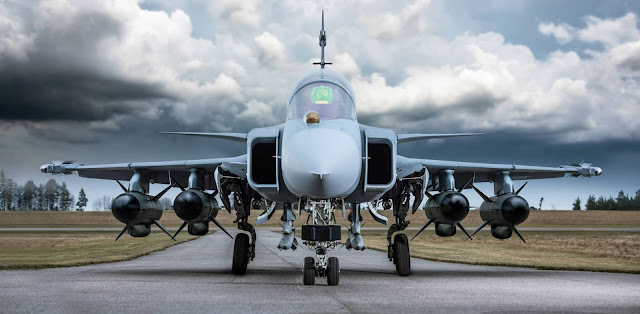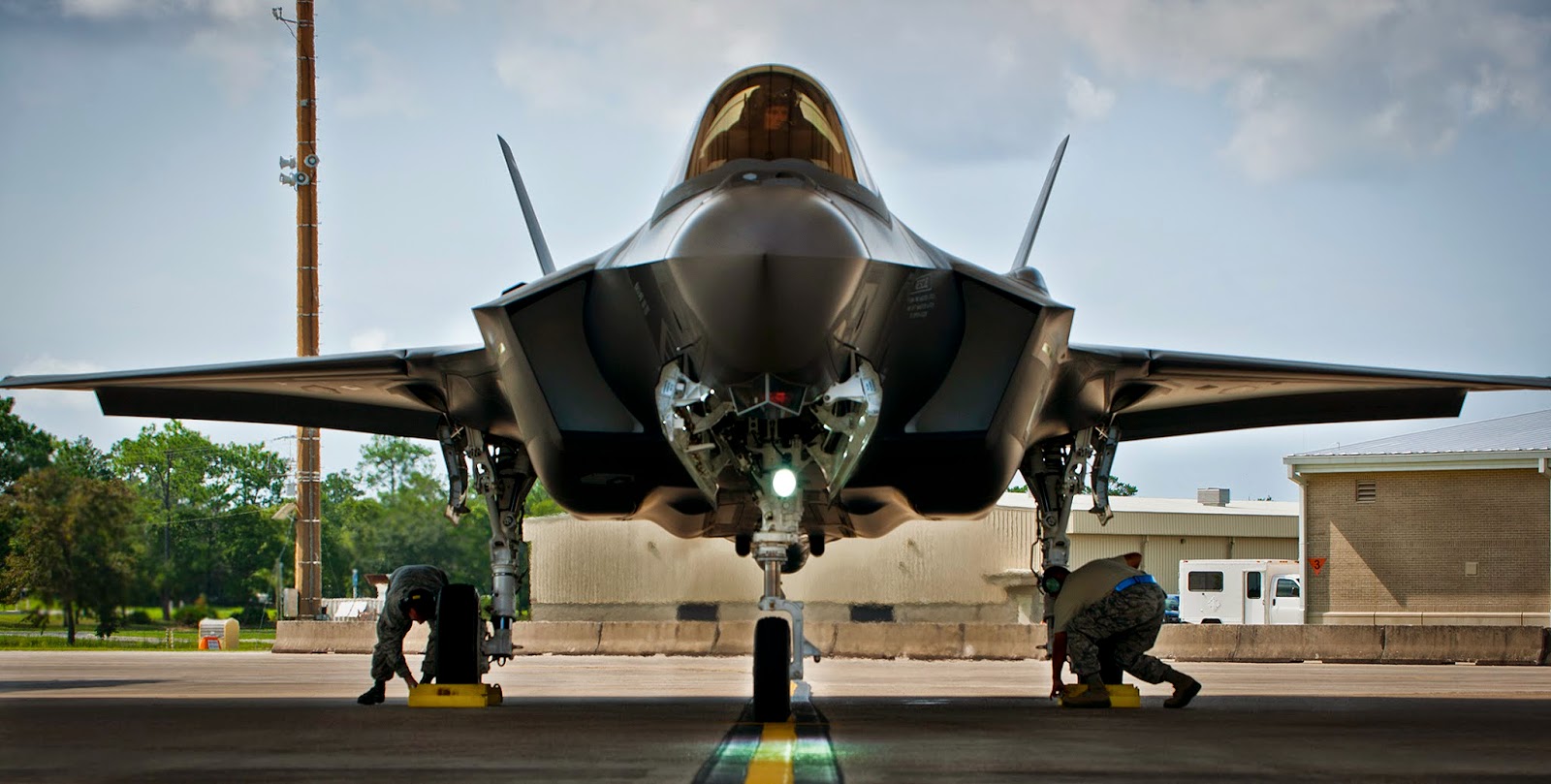Super Hornets: Sensible Upgrade?
 |
| A proposed Super Hornet with conformal fuel tanks and enhanced sensors. |
The answer seems simple, doesn't it? Canada has been using the McDonnell Douglas (now Boeing) CF-18 Hornet since the early 80's. Why not just upgrade Canada's fleet to the new and improved F-18E/F Super Hornet? In theory, this seems like the most sensible solution. The Super Hornet is combat proven, and since it is based on Canada's current CF-18 airframe, it should be an easy switch for our pilots and ground crew. Better yet, Boeing has been marketing the current Super Hornet model to other countries for the rather bargain cost of between $55-90 million a piece (accurate sticker prices on jet fighters being near mythical). The Super Hornet seems to offer a budget price, easy transition, and a way to keep on friendly terms with our neighbours to the south after backing out of the F-35.
However, on closer look, the Super Hornet is in fact a 40 year old design that, while an excellent airframe in and of itself, doesn't offer much of an upgrade to Canada's current CF-18 fleet.
- A (not so) little history:
 |
| The YF-17 "Cobra" prototype. |
In the late 60's, the U.S. Air Force was looking for a light, inexpensive fighter to supplement the F-15. Additionally, it was hoped that the allied air forces would choose the fighter as well. Two prototypes were studied, the General Dynamics YF-16 Fighting Falcon and the Northrop YF-17 Cobra, which first flew in 1974.
 |
| The YF-17 (top) and the YF-16 (bottom). |
Unhappy with the F-16's single engine layout, the U.S. Navy deemed a proposed carrier version unacceptable, and looked elsewhere for fighter to replace its soon to retire F-4s, A-7s, and A-4s. Preferring the YF-17s twin engine layout, the U.S. Navy asked Northrop and McDonnell Douglas, which had far more experience designing carrier based aircraft, to develop a "beefier" version of the YF-17, with more emphasis on a ground attack role. This led to the F/A-18 Hornet, which had its first flight in 1978, a mere 4 years after the YF-17.
 |
| Canada's choice, the CF-18. |
 |
| An artist's rendering of the A-12 Avenger II |
 |
| Bigger and beefier than the Hornet, which was beefier than the Cobra. |
Although it has been heavily marketed by Boeing, so far the Super Hornet has only seen a single buyer outside the U.S. Navy: The Royal Australian Air Force (RAAF).
 |
| A RAAF Super Hornet (above) and its predecessor, the FB-111 "Aardvark". |
The RAAF's purchase of the Super Hornet has been controversial. Intended to replace the FB-111 bomber, the Super Hornet is incapable of matching its predecessor's speed, range, or payload. There was also issue with the fact that the FB-111 wasn't at the end of its service life, but were simply too expensive to fly anymore. The decision was made without tender, at the cost of $6 billion (Australian) for 24 aircraft. Also, if the Australian ordered F-35 is delayed further, it plans to possibly acquire an additional 24 aircraft.
[Note: Much about the RAAF's, current situation, as well as plenty of other topics, can be found at the ausairpower website. This website is a source of much controversy itself, but it remains highly researched and thought out, if opinionated.]
There are a few issues with the Super Hornet however...
- Its airframe design predates most of the pilots that will fly it.
 |
| Boeing's concept of a potential Super Hornet replacement. |
The YF-17 saw its origins in the late 60s, and the prototype flew over 40 years ago. Since then, the design has been beefed up into the F/A-18A/B Hornet, then beefed up again to the F-18E/F Super Hornet.
No one can deny the Hornet's successful years in service, and it has earned plenty of fans and accolades over the years, but it is still a 40 year old design that is being considered for future replacement. Even though Super Hornets are made using more modern construction materials and advanced avionics and sensors, it is still based on a design that predates the personal computer. Aerodynamically, it does not use the same "relaxed stability" as the Gripen, Typhoon, and Rafale. In fact, scaling the design up actually resulted in a few compromises, like canting the weapon pylons outward to allow proper weapon separation at the cost of additional drag.
It may be hard to justify buying a fleet of aircraft that is already near the end of its shelf life. Yes, the new airframes would last us well until 2050, but design itself would be antiquated. Regrettably, the Gripen, Rafale, and Typhoon are still 20 year old designs, having been developed in the late 80s-to-early 90s, but that is still far better than an aircraft designed in the 70s. Yes, the Hornet has seen considerable upgrades to the point where it is pretty much a different aircraft, but the same goes for the Gripen E/F models. Ideally, there would be a compelling 21st century fighter design, but that only leaves the F-35.
- It is simply not that cheap to procure, nor to operate.
 |
| Jane's cost per flight hour estimates. |
As stated earlier, Australia's cost for 24 Super Hornets was $6 billion. Given that Canada's dollar value is close to the Australian dollar's value, one must assume that our cost would be similar. Further Australian Super Hornet purchases are pegged at over $100 million per plane. With a total cost of $8.5 to $9 billion for 48 Super Hornets. Canada's RCAF has stated the need for at least 65 jets, so our cost would undoubtedly be higher still for greater numbers.
Also, as you can see above, the F-18E/F Super Hornet is estimated to cost $11,000 per flight hour. Although this compares quite favourably to the Rafale, F-35, and (adjusted) Eurofighter Typhoon costs, it is more than twice that of the Gripen and significantly higher than the ubiquitous F-16.
Since the Super Hornet shares so few parts with the legacy Hornet, any perceived cost savings have to be deemed suspect. Although the two are similar in appearance, they do in fact, mount different engines, avionics, and share few body panels.
- The Super Hornet is a carrier based, ground attack plane. Not a dogfighter, not an interceptor.
 |
| Maverick's choice: The F-14 Tomcat (foreground) and the F-18E Super Hornet. |
The original Hornet was intended to be "bomb truck". Hence the "A" (for attack) in F/A-18. Air superiority was the realm of the F-14 Tomcat, with the F/A-18 only needing enough of an edge to defend itself if needed. With the retirement of the A-6 Intruder, and the cancellation of the A-12 Avenger II, the U.S. Navy needed a bigger attack plane. Hence the larger Super Hornet. Along the way, the F-14's planned successor, the a swing-wing version of the F-22 Raptor, was cancelled for budget reasons. It was decided that the US carrier fleet would use strictly F-18s for air-to-air combat. this hasn't been the most popular decision. This isn't to say the Super Hornet is incapable of air-to-air combat, it is just that it does not place as much emphasis on the air superiority role as say, the Typhoon.
Indeed, the Super Hornet has seen little export sales so far, with the Gripen and Typhoon being more successful and the Rafale hot off a 108 aircraft deal with India. By contrast, the RAAF is the only export buyer of the Super Hornet so far with 24 aircraft.
- Okay... Maybe we can make a partial exception...
 |
| Maybe a few of these... At most. |
Canada's close relationship with the U.S.A. enable us to be one of the few countries that would be able to receive permission to purchase a variant of the Super Hornet known as the EF-18G "Growler" electronic warfare aircraft. This variant deletes the nose-mounted 20mm cannon in favour of electronic attack equipment that allow it jam enemy radar and communications. These craft are often in high demand in the battlefield and the RAAF has announced that 12 of its Super Hornets will undergo conversion to the EF-18G standard, making it the first, and so far only, non-US country to do so.
Now, replacing Canada's entire fleet of CF-18s to "Growlers" would be foolish. They are simply too specialized a platform to operate as our sole jet fighter. But a small number, say 6-12, would make us an invaluable addition to any coalition force. Like Australia, a small force of Super Hornets could likely be a very good choice if Canada needs an "interim fighter", especially if those interim fighters could later be converted to Growler standard.



True. F18EFG is probably better classified as a multirole ground attack aircraft capable of reasonably defend itself in A/A; it's thought to be slightly less maneuverable but far more versatile than classic Hornet. RAAF seeks to reclassify its F18F & G as a support aircraft.
ReplyDelete'F-35′s Stealth, EW Not Enough, So JSF And Navy Need Growlers' -that article in Breaking Defense Apr 10 2014 you link to, would perhaps highlight yet some more reasons just buying 65 of the F35s as a replacement for the CF18s needs a rethink.
ReplyDeleteOn the other hand if Boeing is going to be contracted to build some more Growlers for the US Navy, keeping their production train running for awhile then your suggestion in an older post to buy 6 or 12 of them for RCAF is worth revisiting:
'Now, replacing Canada's entire fleet of CF-18s to "Growlers" would be foolish. They are simply too specialized a platform to operate as our sole jet fighter. But a small number, say 6-12, would make us an invaluable addition to any coalition force. Like Australia, a small force of Super Hornets could likely be a very good choice if Canada needs an "interim fighter", especially if those interim fighters could later be converted to Growler standard.'
I would like to hear the experts defending this idea of a multirole fighter, especially the F35 'its going to be a rugged fighter,able to do everything well' weigh in on this.